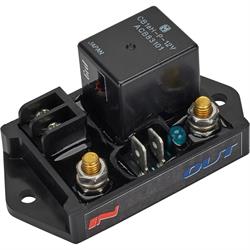How to Wire Dual Electric Cooling Fans
Misconceptions About Wiring Dual Electric Cooling Fans
As many of you know, clearance between the front of your engine and radiator can be very tight. Most of the time your first thought is to find the slimmest single electric fan possible that’s powerful enough to cool your car, but wait, there’s a second option! Dual electric fans could be the solution to your cooling issues. You might think, “I don’t know how to wire up dual fans.” Here at Speedway Motors we’re happy to help you understand the process. Dual electric fans have several benefits, including being able to pull more cfm between the two fans versus having just one fan, also allowing more clearance for front engine accessories, and covering more of your radiator's core for efficient airflow and cooling without having to fabricate a custom fan shroud that you might not even have the room for.
How Do You Wire Dual Cooling Fans?
There are several ways that a dual fan setup can be wired. For example, dual relays could be used to control each fan separately. This is a great option to control one fan by engine temperature and the other by air conditioning load (second fan comes on with compressor engagement) or with a manual switch. Optionally, a single high-current relay could be used to control both fans. The supplied diagram below using dual relays with a single temp sensor is both the most reliable and easiest method we've found for wiring dual fans. It uses our 40-Amp Electric Relay Kit and Electric Fan Sensor. The relay isolates the high amp load of the fan circuit from the switching circuit, while the temperature sensor controls the fan on/off by your engine's coolant temp.
Is It Safe to Use One Relay for Dual Cooling Fans?
We have sometimes witnessed people wire up dual fans using a single standard relay to control both fans. We have found this to be inefficient and somewhat dangerous, as most dual fans pull enough load in amps at start up to blow the fuse for the single relay. This is normally around a 30 amp fuse to protect the wiring and relay, which is not enough to support dual fans engaging at the same time. A high-current single relay controller can often tackle this job, but at greater expense than two simple relays like in our diagram below. If you're really pressed for space in your engine bay the single high-current relay is certainly an option.
Can Dual Cooling Fans Be Controlled Separately?
Yes, you can control dual fans separately. You can use dual thermostatic switches that control each fan individually for example. This method requires a second temperature switch, a little additional wiring, and of course dual relays. Some prefer to have the second fan on a manual switch for additional "emergency" cooling, while others will wire their second fan to use the air conditioning compressor signal to engage the second fan. There are even fancy controllers and in-dash temperature gauges with fan outputs, as well as cooling fan outputs on most aftermarket fuel injection systems, to control one or both fans. Controlling the fans individually can be beneficial in certain circumstances, but usually is unnecessary extra work, as most of the time you only want your fans on to cool the car down then to have them shut off. For the setup shown here we used two of Speedway's curved blade universal electric cooling fans. These are available in 8, 10, 12, 14, or 16 inch diameters to fit most any downflow or crossflow radiator application. These fans can be directly mounted to the core with our nylon mounting kit or if you have the room for a full aluminum fan shroud to cover your radiator's core even better!
Wiring Process For Dual Radiator Cooling Fans
The color coded diagram below will correspond with the wires on the relay kit we linked to earlier (and listed at the bottom of this article) to help simplify the wiring process. Start with taking both of the positive wires from the fans and connect them to the yellow wires on each relay. You will then need to run switched power (usually from your ignition switch, but modern replacement wiring harnesses usually have a fused fan relay trigger wire) to the blue wires on the relays. Next, both of the black wires from the relays are spliced together and connected to your thermostatic switch. Lastly, connect a fused constant power to both of the red wires on the relays. This is the load side of the relay and you should use a minimum of 14 gauge wire here. The white wire on the relay pigtail will not be used. With these dual fans wired up you can keep your car cool and not have to worry about clearance issues!
Updated by Mark Houlahan



